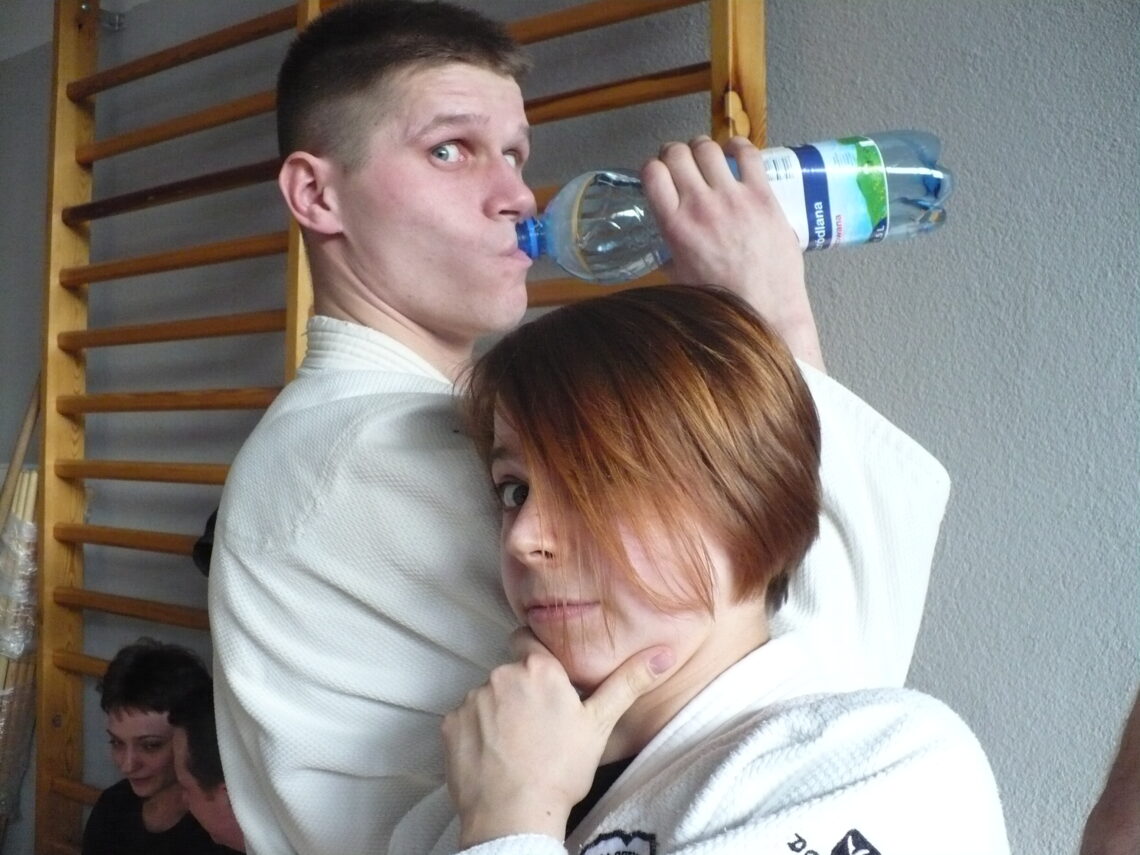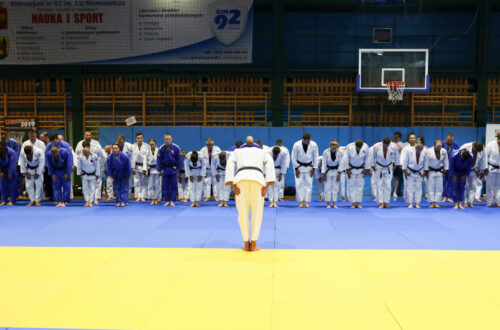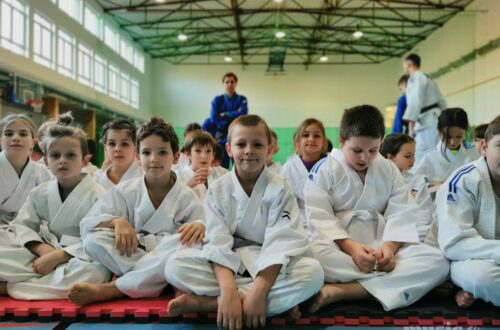
Jesteś pewien, że masz czarny pas?|Are you sure you have a black belt?
Jakiś czas temu pisałam o samodoskonaleniu. Poruszałam temat staży, seminariów. Napisałam również, że nikt nie jest nieomylny, i że mistrz nadal jest uczniem.
Dzisiaj chciałabym coś jeszcze dodać. Coś, o czym zapomina 80% trenujących – że stopnie w sztukach walki są dynamiczne.
Twój czarny pas (albo brązowy, niebieski – w zależności od tego jaki nosisz na biodrach) jest tak samo dynamiczny jak olimpijskie medale Usain Bolta.
Teraz wyobraź sobie tego wspaniałego sportowca, jak zaczepia kogoś z komisji olimpijskiej pytając czy na następnych igrzyskach może nosić swoje stare medale.
Otóż nie może. Musi na kolejnych igrzyskach pokazać, że te poprzednie medale nie były tylko sumą przypadków i szczęścia.
W sztukach walki jest podobnie.
Twój pas, nieważne jakiego koloru, jest jak medal olimpijski. Przez wiele lat trenowałeś bardzo ciężko, by go zdobyć, by na niego zasłużyć. To jakby pomiar Twojego poziomu w aktualnej chwili. I od Ciebie zależy czy utrzymasz ten poziom.
To, że 10 lat temu ćwiczyłeś judo i zdobyłeś czarny pas, nie znaczy, że nadal go masz. Zwłaszcza jeśli od tamtego momentu nie pojawiłeś się na żadnym treningu wspomnianej sztuki walki.
Pasa nie można porównać do odznaczenia wojskowego, które nosi emerytowany żołnierz. Widzimy medal i wiemy, że otrzymał go za stare zasługi. On już nie jest na wojnie i nie musi nikomu nic udowadniać.
Ale my musimy. Mamy iść do przodu, rozwijać się, a nie spoczywać na laurach.
W Japonii mistrzowie mający po 65/75 lat (i więcej) wciąż trenują i dają z siebie wszystko. Chętnie zrobią z Tobą 100 choku zuki stojąc w kiba dachi i zrobią to dla zabawy!
Stale reprezentują swój poziom, ciągle ćwiczą. Bez wahania zdejmą swoje czarne pasy, by założyć biały. Na znak, że się uczą, nie są nieomylni.
Teraz, porównaj to z zachodnimi „mistrzami”, którzy od momentu uzyskania swojej rangi nie uczestniczyli czynnie w jakimkolwiek treningu. A to było 20 lat temu. W rzeczywistości dumnie wypinają pierś i noszą pas reprezentujący ich 20 lat młodsze ja.
Interesujące, jednak niezbyt zgodne z budo, prawda?
Przez te kilkanaście lat mojego treningu sztuk walki miałam okazję spotkać wielu ludzi. Od naprawdę zaangażowanych uczniów, przez świetnych kolegów na sali treningowej, aż na wspaniałych sensei kończąc. Kilkoro z nich ma osobne miejsce w moim sercu.
Ale jest jedna osoba, która wyryła się w moim mózgu.
Czym mnie urzekła?
Otóż ten chłopak – wtedy 15 letni – podszedł przed zajęciami do mojej sensei od judo. I zapytał, czy może nosić swój biały pas.
„I co w tym niezwykłego?” spytacie.
Nic, gdyby nie fakt, że od kilku miesięcy był posiadaczem niebieskiego.
Jak sam stwierdził, nie jest w stanie podtrzymywać standardów niebieskiego pasa i pokornie prosił o pozwolenie na degradację samego siebie.
Gdy moja sensei już pozbierała swoją szczękę z podłogi, powiedziała, że naprawdę nie musi tego robić. Zdobył niebieski pas za konkretne umiejętności i jego celem powinno być popychanie samego siebie do granic możliwości na każdym treningu. Dążenie do jak najwyższego poziomu. Wtedy może być pewien, że jest godzien nosić swój niebieski pas.
Jak najlepiej udowodnić, że zasługuję na pas, który noszę?
Stale się rozwijając.
Jeżdżąc na staże, ucząc się, słuchając trenera i myśląc.
Oraz wkładając maksimum wysiłku w trening.
Ponieważ trening wykonany w 99% jest w 100% złym treningiem. Właśnie ten 1% dzieli nas od mistrzostwa.
#dynamizmstopni #sztukiwalki #pokora #mistrzostwo
Some time ago I wrote about self-improvement. I was talking about internships and seminars. I also wrote that no one is infallible and that the master is still a student. Today I would like to add something else. Something that 80% of trainees forget – that martial arts grades are dynamic.
The black belt (or brown or blue belt – depending on what you wear on your hips) is as dynamic as Usain Bolt’s Olympic medals.
Now imagine this great athlete talking to someone on the Olympic committee asking if they can wear their old medals at the next Olympics. Well, it can’t. He has to show at the next Olympics that these previous medals were not only the sum of luck and luck.
It’s the same in the martial arts.
Your belt, no matter what color, is like an Olympic medal. For many years you have trained very hard to get it, to earn it. It’s like measuring your level in the present moment. And it’s up to you to keep this level.
Just because you practiced judo 10 years ago and won a black belt doesn’t mean you still have one. Especially if you haven’t appeared in any of the martial arts training since then.
The belt cannot be compared to the military decoration worn by a retired soldier. We see the medal and we know that he received it for his old services. He’s not in the war anymore and doesn’t have to prove anything to anyone.
But we must. We are to move forward, develop, not rest on our laurels.
In Japan, champions aged 65/75 (and older) are still training and doing their best. They would love to do 100 chokuzuki with you while standing in kiba dachi and do it just for fun!
They are constantly at their level, they are constantly exercising. Without hesitating, they would take off their black belts to wear the white one. As a sign that they are learning, they are not infallible.
Now, compare this with Western „champions” who have not actively participated in any training since their rank. And that was 20 years ago. In fact, they proudly stick out their breasts and wear a belt that represents their 20 years younger self.
Interesting, but not very budo compatible, right?
During these several years of my martial arts training, I had the opportunity to meet many people. From really committed students, through great colleagues in the training room, to great sensei. Several of them have a separate, great and warm place in my heart.
But there is one person engraved in my brain. What did captivate me with?
Well, this boy – then 15 years old – approached my judo sensei before class. And he asked if he could wear his white belt.
„What’s so special about that?” you may ask. Nothing but the fact that he had been the owner of the blue one for several months.
As he himself stated, he was incapable of upholding the standards of the blue belt, and he humbly asked to be allowed to degrade himself.
Once my sensei had picked her jaw off the floor, she said he really didn’t need to do this. He has earned a blue belt for specific skills and his goal should be to push himself to the limit in every training session. Striving for the highest possible level. Then he can be sure that he is worthy to wear his blue belt.
What’s the best way to prove that I deserve the belt I’m wearing?
Constantly growing.
Going to internships, learning, listening to the trainer and thinking.
And putting maximum effort into training. Because a workout done 99% is 100% bad training. It is this 1% that separates us from the championship.




